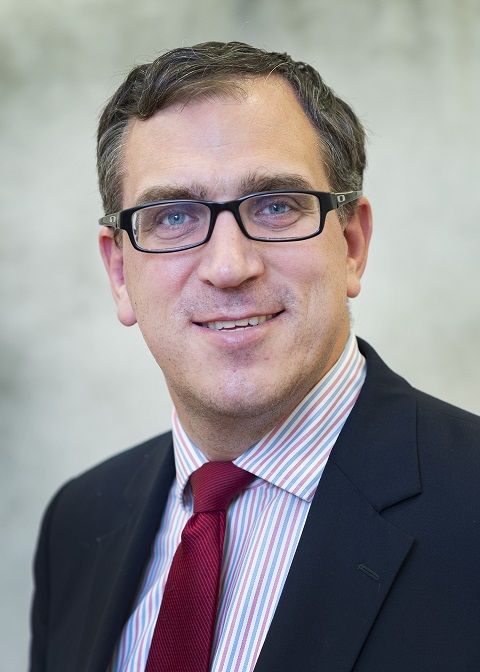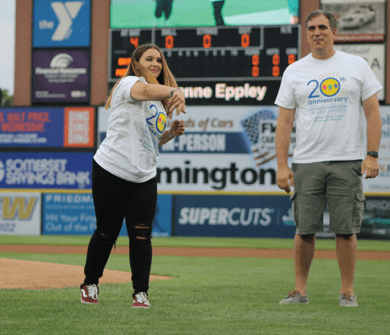“I feel amazing. I can move. I can do so much more physical activity without feeling pain.”
New Jersey teen's painful hip dysplasia successfully treated with Orthopedic surgery
Throughout her entire childhood, Cheyanne Eppley suffered from painful hip dysplasia that limited her activity levels. A surgical procedure called a periacetabular osteotomy performed at The Bristol-Myers Squibb Children's Hospital by RWJBarnabas Health Medical Group pediatric orthopedic surgeon Thomas McPartland, MD has Cheyanne back in the game and ready to play.
A year ago, Cheyanne Eppley of Hamilton Township could barely move without excruciating pain. The 13-year-old had trouble just walking around a grocery store and often woke so stiff and sore that she needed help getting out of bed.
Today Cheyanne is living her best life. The eighth grader alternates between defense and goalie on her soccer team and has rejoined the jazz and hip-hop dance classes that once gave her so much joy.
Cheyanne’s mobility problems stemmed from a form of hip dysplasia—a condition in which the thighbone (femur) doesn’t properly fit with the pelvis. In Cheyanne’s case, the hip socket was too shallow, allowing the ball at the top of the femur to slip out, or dislocate. The dysplasia damaged the joint, leading to pain and loss of function.
Athletic children like Cheyanne— particularly if they participate in activities that place a load on their hips such as dance, hockey, soccer and football—can develop challenging symptoms of hip dysplasia early in life.
“We went to several different doctors and hospitals to try and figure out where the pain was coming from and what to do about it,” says Cheyanne’s mother, Samantha, an interventional radiology scheduling coordinator at Robert Wood Johnson University Hospital (RWJUH) Hamilton. “They said they couldn’t fix it until she was done growing, which wouldn’t be until she was about 16. At that point, she would need a double hip replacement.”
Cheyanne tried to find relief through a chiropractor. She had her shoes fitted with orthotic inserts to correct her gait so forces that the feet absorb from walking or running were less likely to send tightness and pain up her legs and exacerbate her hip pain.
“I wanted to play soccer a lot more than I did, but really didn’t get to because I had so much pain,” Cheyanne says. “It was unbearable.” She also was sidelined during family activities like bicycling and hiking.
The breaking point came when Cheyanne began waking every morning in agony, unable to get out of bed. “We’d have to give her medicine to reduce her pain and calm her down,” Samantha says. “There were a couple of times when the hip locked up and needed a few hours of manipulation and massage. It was difficult seeing her in that much pain.”
Turning to Experts

Samantha finally reached out to the pediatric orthopedic team at The Bristol-Myers Squibb Children’s Hospital at Robert Wood Johnson University Hospital. She was referred to Thomas McPartland, MD, Assistant Clinical Professor of Pediatric Orthopedic Surgery at Rutgers Robert Wood Johnson Medical School and a member of RWJBarnabas Health Medical Group, who specializes in treating complex orthopedic deformities, including those of the hips.
Based on Cheyanne’s imaging tests, symptoms and history, Dr. McPartland proposed a treatment the Eppleys didn’t expect: a procedure that would correct Cheyanne’s problem but preserve her natural hip joints.
“You want to avoid doing a hip replacement in a young person, because the likelihood is very high that the artificial joint will eventually wear out,” Dr. McPartland says. “She’s going to be much better off with her native hip. A living part of your body can remodel itself, where a hip replacement will not.”
Dr. McPartland would perform a procedure called periacetabular osteotomy, which reshapes the hip joint in people with hip dysplasia. It involves cutting the pelvis around the hip joint, reorienting it and allowing it to heal in a more favorable position. “There is good data that this will change the course of the hip’s natural life, and therefore change its function,” Dr. McPartland says. “Cheyanne could have pain-free function for the rest of her life.”
A Fresh Start
Cheyanne fared well during the nine-hour operation in November 2020 and was off her post-op medications after two weeks. “Suddenly I felt no more pain,” she says. “It was amazing!”
After a stint on crutches and a regimen of physical therapy, Cheyanne was cleared for normal activity in May 2021. “Over the summer, she would randomly just get up and start running around outside,” Samantha says. “She kept saying, ‘I want to go back to soccer, and I’m going to dance again.’ So now we’re starting all of that over.”
 In September, Cheyanne’s family, Dr. McPartland and a stadium full of well-wishers celebrated her triumph at a special Somerset Patriots baseball game honoring the 20th anniversary of the children’s hospital. The reward for her trials: the chance to throw out the first pitch.
In September, Cheyanne’s family, Dr. McPartland and a stadium full of well-wishers celebrated her triumph at a special Somerset Patriots baseball game honoring the 20th anniversary of the children’s hospital. The reward for her trials: the chance to throw out the first pitch.
“Her dad was on the field with her while I was videoing the whole thing, crying in the stands,” says Samantha. “My greatest hope is that we won’t have to face any type of corrective surgery again.”
Cheyanne has more immediate dreams. “Once I get my strength back, I am getting into competitive dance,” she says. “I feel like a new person.”
For more information visit Pediatric Orthopedics at The Bristol-Myers Squibb Children's Hospital.